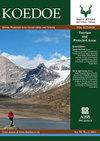Woody cover mapping in the savanna ecosystem of the Kruger National Park using Sentinel-1 C-Band time series data
IF 1.1
4区 环境科学与生态学
Q3 BIODIVERSITY CONSERVATION
引用次数: 11
Abstract
Savanna ecosystems are dominated by different densities of grasses and woody plants with inter-annual changes because of dry and wet seasons. They cover half of the African continent and around 20% of the global land surface and are of great significance for ecology (e.g. living environment) and economy (e.g. fuelwood, timber) (Kutsch et al. 2008; Main et al. 2016; Scholes & Walker 1993). The savanna ecosystems of South Africa are shaped by disturbance processes such as droughts, fire and herbivory (Druce et al. 2008; Scholes & Archer 1997; Stevens et al. 2016), as well as anthropogenic impacts like climate change (e.g. increase in atmospheric CO2) or management actions. It is therefore not surprising that these savannas have been undergoing various changes during the last decades (Buitenwerf et al. 2012; Skowno et al. 2016). Information about changes in woody cover and above-ground biomass (AGB) in national parks (e.g. Kruger National Park [KNP]) is important for park management and conservation efforts, as changes in woody cover are likely to have effects on other ecosystem patterns and processes. For example, an increase in woody cover will lead to a reduction in grass and herbaceous biomass (Berger et al. 2019), which will have cascading effects on herbivores (i.e. favouring browsers to grazers [Smit & Prins 2015]) and fire regimes (i.e. reducing fire frequency [Smit et al. 2012]). The savanna ecosystems in South Africa, which are predominantly characterised by woody vegetation (e.g. shrubs and trees) and grasslands with annual phenological cycles, are shaped by ecosystem processes such as droughts, fires and herbivory interacting with management actions. Therefore, monitoring of the intraand inter-annual vegetation structure dynamics is one of the essential components for the management of complex savanna ecosystems such as the Kruger National Park (KNP). To map the woody cover in the KNP, data from European Space Agency’s (ESA) Copernicus Sentinel-1 radar satellite (C-Band vertical– vertical [VV]/vertical–horizontal [VH]) for the years 2016 and 2017, at 10 m spatial resolution and repeated acquisitions every 12 days, were utilised. A high-resolution light detection and ranging (LiDAR) data set was reclassified to produce woody cover percentages and consequently used for calibration and validation. Woody cover estimation for different spatial resolutions was carried out by fitting a random forest (RF) model. Model accuracy was assessed via spatial cross-validation and revealed an overall root mean squared error (RMSE) of 22.8% for the product with a spatial resolution of 10 m and improved with spatial averaging to 15.8% for 30 m, 14.8% for 50 m and 13.4% for 100 m. In addition, the product was validated against a second LiDAR data set, confirming the results of the spatial crossvalidation of the model. The methodology of this study is designed for savanna vegetation structure mapping based on height estimates by using open-source software and open-access data, to allow for a continuation of woody cover classification and change monitoring in these types of ecosystems.利用Sentinel-1 c波段时间序列数据绘制克鲁格国家公园稀树草原生态系统的林木覆盖图
稀树草原生态系统以不同密度的禾本科和木本植物为主,因干湿季节而有年际变化。它们覆盖了非洲大陆的一半和全球陆地表面的20%左右,对生态(如生活环境)和经济(如薪柴、木材)具有重要意义(Kutsch等人,2008;Main et al. 2016;Scholes & Walker 1993)。南非的稀树草原生态系统受到诸如干旱、火灾和草食等干扰过程的影响(德鲁斯等人,2008;Scholes & Archer 1997;Stevens et al. 2016),以及气候变化(如大气二氧化碳增加)或管理行动等人为影响。因此,这些稀树草原在过去几十年里经历了各种变化也就不足为奇了(Buitenwerf et al. 2012;Skowno et al. 2016)。关于国家公园(如克鲁格国家公园[KNP])树木覆盖和地上生物量(AGB)变化的信息对公园管理和保护工作很重要,因为树木覆盖的变化可能对其他生态系统模式和过程产生影响。例如,树木覆盖的增加将导致草和草本生物量的减少(Berger等人,2019年),这将对食草动物(即偏爱食草动物[Smit & Prins 2015])和火灾制度(即减少火灾频率[Smit等人,2012])产生级联效应。南非的稀树草原生态系统主要以木本植被(如灌木和树木)和具有年度物候周期的草原为特征,由干旱、火灾和草食与管理行动相互作用等生态系统过程形成。因此,监测年际植被结构动态是克鲁格国家公园(KNP)等复杂稀树草原生态系统管理的重要组成部分之一。为了绘制KNP的树木覆盖,利用了欧洲航天局(ESA)哥白尼哨兵1号雷达卫星(c波段垂直-垂直[VV]/垂直-水平[VH]) 2016年和2017年的数据,以10米空间分辨率和每12天重复获取一次。高分辨率光探测和测距(LiDAR)数据集被重新分类,以产生树木覆盖百分比,并随后用于校准和验证。通过拟合随机森林(RF)模型,对不同空间分辨率下的植被覆盖度进行估算。通过空间交叉验证对模型精度进行了评估,结果显示,在空间分辨率为10 m时,产品的总体均方根误差(RMSE)为22.8%,在空间平均分辨率为30 m时为15.8%,在空间平均分辨率为50 m时为14.8%,在空间平均分辨率为100 m时为13.4%。此外,该产品还针对第二组LiDAR数据集进行了验证,确认了模型的空间交叉验证结果。本研究的方法是利用开源软件和开放获取的数据,基于高度估计进行稀树草原植被结构制图,以便在这些类型的生态系统中继续进行木本覆盖分类和变化监测。
本文章由计算机程序翻译,如有差异,请以英文原文为准。
求助全文
约1分钟内获得全文
求助全文
来源期刊

Koedoe
BIODIVERSITY CONSERVATION-
CiteScore
3.30
自引率
0.00%
发文量
10
审稿时长
20 weeks
期刊介绍:
Koedoe, with the subtitle ''African Protected Area Conservation and Science'', promotes and contributes to the scientific (biological) and environmental (ecological and biodiversity) conservation practices of Africa by defining the key disciplines that will ensure the existence of a wide variety of plant and animal species in their natural environments (biological diversity) in Africa.
 求助内容:
求助内容: 应助结果提醒方式:
应助结果提醒方式:


